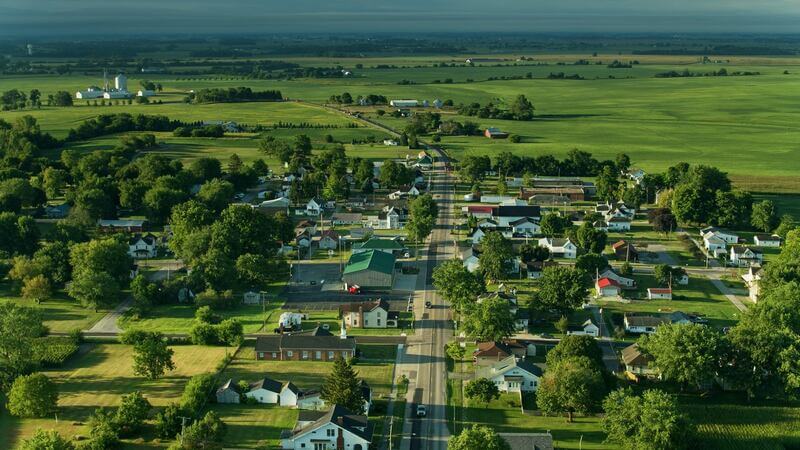Get Pre-Approved Today!
Check Rates with Multiple Lenders and Get Pre-Approved in Minutes!



USDA Home Loans: A Complete Guide for 2025
If you’re looking to buy a home in a rural area, a USDA home loan can be an excellent financing option.
The USDA loan program, backed by the U.S. Department of Agriculture, helps low to moderate-income families purchase homes with no down payment and lower interest rates.
In this comprehensive guide, we’ll explore the USDA home loan requirements, benefits, and how it compares to other types of mortgages.
What is a USDA Home Loan?
A USDA home loan is a mortgage program backed by the United States Department of Agriculture and is designed to promote homeownership in rural areas by providing affordable loans to eligible borrowers.
These loans offer 100% financing, meaning no down payment is required. USDA loans are intended for individuals who have steady but low or moderate incomes and are unable to qualify for conventional financing.
Key Features of USDA Loans:
- No down payment required.
- Low interest rates.
- Flexible credit requirements.
- Competitive fixed interest rates.
- No private mortgage insurance (PMI).
“USDA loans offer a unique opportunity for families who may not have the upfront cash for a traditional down payment,” explains Jennifer Moore, Senior Loan Specialist at Farmhouse Lending Group. “These loans can make homeownership more accessible for those in rural and suburban areas.”
USDA Loan Requirements
To qualify for a USDA loan, there are specific eligibility criteria that borrowers must meet:
- Property Location: The home must be located in a USDA-eligible rural area. The USDA defines rural areas as towns with populations of 35,000 or less, but some suburban areas also qualify.
- Income Limits: Borrower’s household income cannot exceed 115% of the area median income (AMI).
- Credit Score: Typically, a minimum credit score of 640 is required, but some lenders may approve lower scores with compensating factors.
- Employment Stability: A steady employment history for at least two years is preferred.
- Debt-to-Income Ratio (DTI): The DTI ratio should not exceed 41%, but some lenders may allow a higher ratio with strong compensating factors.
Types of USDA Loans
The USDA offers two main types of home loans:
1. Single-Family Housing Guaranteed Loan Program
This program helps low to moderate-income households buy, build, or improve a home in an eligible rural area. USDA guarantees the loan, allowing lenders to offer lower interest rates and no down payment options.
- Minimum credit score of 640.
- Income limits depend on location and household size.
- Property must be in a USDA-eligible area.
- No maximum loan limit.
2. Single-Family Housing Direct Loan Program
This program is aimed at very low-income borrowers. USDA issues the loan directly rather than guaranteeing it through a lender.
- Income limits are much lower than the Guaranteed Loan Program.
- Borrowers may qualify for payment assistance, reducing monthly payments.
- Minimum credit score is typically lower, but approval depends on other factors.
“USDA’s Direct Loan Program is a lifeline for families that otherwise couldn’t afford to buy a home,” notes Mark Davidson, Mortgage Advisor at Rural Lenders United. “It provides opportunities to those who need more flexible options.”
USDA Loan Limits and Rates
Unlike conventional loans, USDA loans don’t have a set maximum loan amount. Instead, the loan limit is determined based on the borrower’s ability to repay and their income. Interest rates for USDA loans are usually lower than conventional loans because of the government guarantee.
- Current USDA Loan Rates (2024): Rates are typically 0.5% to 1% lower than conventional rates.
- Annual Fee: Instead of PMI, USDA loans charge an annual fee of 0.35% of the loan amount, which is much lower than the typical PMI rate.
Benefits of USDA Home Loans
USDA loans offer several advantages compared to other mortgage options:
- No Down Payment Required: USDA loans provide 100% financing, making it ideal for buyers who lack funds for a down payment.
- Lower Monthly Payments: USDA loans have low interest rates and no PMI, which helps lower the monthly payment.
- Lenient Credit Requirements: USDA loans are accessible to those with less-than-perfect credit, making them a good choice for first-time buyers.
- Flexibility for Property Types: USDA loans can be used to purchase single-family homes, manufactured homes, or even land to build a home.
How USDA Loans Compare to Other Loan Programs
Below is a comparison of USDA loans with other common mortgage options:
| Loan Type | Minimum Credit Score | Down Payment | Income Limits | Property Type |
|---|---|---|---|---|
| USDA Loan | 640 | 0% | 115% of AMI | Rural/Eligible Suburban |
| FHA Loan | 580 | 3.5% | No Limits | Single-Family/Condo |
| VA Loan | 580-620 | 0% | Veteran Benefits | Single-Family/Condo |
| Conventional Loan | 620 | 3%-20% | No Limits | Single-Family/Investment |
“USDA loans are a great option if you qualify based on location and income,” says Richard Green, Mortgage Expert at HomeSource Lending. “However, if you’re not in a rural area, FHA or conventional loans might be better alternatives.”
How to Apply for a USDA Loan
Applying for a USDA loan is similar to other mortgage types but requires additional verification of property location and income.
- Determine Eligibility: Check if the property is in an eligible area using the USDA Property Eligibility Map.
- Choose a Lender: Find a lender that offers USDA loans. Not all lenders are USDA-approved.
- Pre-Approval: Submit your financial information for pre-approval.
- Find a Home: Work with a real estate agent to find a home that meets USDA requirements.
- Submit Application: Provide all necessary documentation, including proof of income, credit history, and property information.
- Underwriting and Closing: The lender will process your loan, and the USDA will approve it before closing.
Common Challenges and Misconceptions
Many people assume USDA loans are only for farmers or properties in very remote areas. However, the USDA loan program encompasses many suburban areas, making it accessible to a larger population. Another misconception is that USDA loans are harder to qualify for due to income limits, but these limits vary by location, and many people may be eligible without realizing it.
USDA Loan Frequently Asked Questions
What is a USDA loan, and how does it work?
A USDA loan is a zero-down-payment mortgage option for rural and suburban homebuyers. It’s backed by the U.S. Department of Agriculture, making it easier for lenders to offer lower rates and lenient requirements.
Who is eligible for a USDA loan?
Eligibility is based on the property location, household income, and credit score. The property must be in a USDA-eligible rural area, and household income cannot exceed 115% of the area median income.
Do USDA loans require mortgage insurance?
No, USDA loans do not require traditional private mortgage insurance (PMI). Instead, they have an annual fee of 0.35% of the loan amount, which is much lower than typical PMI rates.
Can I use a USDA loan to buy a second home or investment property?
No, USDA loans are only for primary residences. You cannot use them to buy second homes or investment properties.
What is the maximum loan amount for a USDA loan?
There is no specific maximum loan amount for USDA loans. The amount is determined by your income, ability to repay, and property appraisal value.
How long does it take to close on a USDA loan?
The average closing time for a USDA loan is about 45-60 days. This may vary depending on the lender and any additional requirements.
What are the credit score requirements for a USDA loan?
While the USDA doesn’t set a minimum credit score, most lenders require at least a 640 credit score. Some may consider lower scores with compensating factors.
Can I refinance a USDA loan?
Yes, USDA offers a Streamlined Refinance option for current USDA borrowers to lower their interest rate or change loan terms without a new appraisal or income verification.
Can I get a USDA loan with student loan debt?
Yes, USDA loans consider your total debt-to-income ratio, including student loans. As long as your DTI is below 41% (or higher with compensating factors), you may still qualify.
How do I know if my property is in a USDA-eligible area?
You can use the USDA Property Eligibility Map to check if your desired property is in a qualifying area.
The Bottom Line
USDA loans are an excellent option for those looking to buy a home in rural or suburban areas without the burden of a down payment. With lenient credit requirements and competitive interest rates, USDA loans make homeownership accessible to more families. While the eligibility criteria may seem strict, many suburban neighborhoods qualify as rural areas, expanding the program’s reach. For more information and to see if you qualify, consult with a USDA-approved lender.






